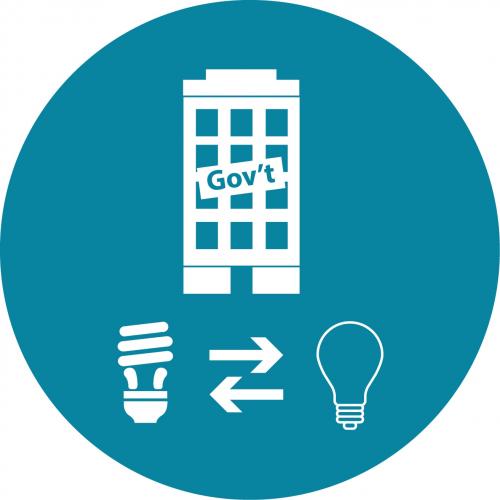Energy Efficiency in Public Buildings
PROGRAM AREA: ENERGY EFFICIENCY
FUNDING LEVEL: One-time allocation; $20 million in 2014-15 budget
ADMINISTERING AGENCY: California Energy Commission (CEC)
energy generation projects in public buildings, including the University
of California, the California State University, and courts. Energy
savings projects will include lighting systems, energy management
systems and equipment controls, building insulation and heating,
ventilation, and air conditioning equipment. Eligible projects include
building retrofits for energy efficiency and energy generation. Program
funding awards will be made in July 2015.
Visit the California Energy Commission’s website to learn more.
of this program that is funded through cap and trade, however, CEC
administers a similar program under the “Energy Conservation Assistance
Act” (ECAA). Under the ECAA cities and counties may apply directly for
financing energy efficiency improvements on public structures such as
city halls or parking lots, as well as street lighting or solar panels.
Historically, local jurisdictions have received 59% of ECAA funds and
have had successful project outcomes.
solar electric systems on city facilities. These include a 12.1
kilowatt (kW) grid-tied, rooftop solar photovoltaic (PV) system
installed at city hall and a 2.3 kW grid-tied, rooftop solar PV
system at the Arcata Marsh Interpretive Center. The Energy Program has
been active in energy- and climate change-related activities since 2000.
One of the main tasks of the Energy Program is to assist with the
implementation of the goals and strategies outlined in the Community
Greenhouse Gas Reduction Plan. The Energy Program promotes energy
efficiency and conservation, renewable energy, water-use efficiency, and
sustainability through outreach and education and through the
implementation of energy efficiency and renewable energy projects around
the community. The Energy Program also serves as an information
resource for residents and business owners interested in seeking ways to
include energy efficient practices in their daily lives.
Example of Eligible Project: City of Chula Vista
Chula Vista continues to invest in its future through comprehensive
staff trainings and energy benchmarking of all its major buildings. Over
54 municipal facilities have had energy upgrade improvements in the
last five years that reduce utility costs and improve operations. Around
town, over 7,000 streetlights were converted to energy-saving LED
technology. Through its partnership with SDG&E®, the City of Chula
Vista created innovative approaches to advance municipal and community
energy efficiency. Underserved audiences like small businesses, elderly,
youth and low-income residents are reached through a comprehensive
outreach network that leverages libraries, recreation centers,
affordable housing services, business licenses and permit application
processes. Grassroots energy conservation education combined with
facility improvements, energy codes and inspections, and energy-saving
development has distinguished Chula Vista as a model municipal
environmental champion.
ADMINISTERING AGENCY: California Energy Commission (CEC)
Program Description
This first-come, first served program is for energy efficiency andenergy generation projects in public buildings, including the University
of California, the California State University, and courts. Energy
savings projects will include lighting systems, energy management
systems and equipment controls, building insulation and heating,
ventilation, and air conditioning equipment. Eligible projects include
building retrofits for energy efficiency and energy generation. Program
funding awards will be made in July 2015.
Visit the California Energy Commission’s website to learn more.
Successful Project Attributes
Local governments are not eligible to apply directly for the portionof this program that is funded through cap and trade, however, CEC
administers a similar program under the “Energy Conservation Assistance
Act” (ECAA). Under the ECAA cities and counties may apply directly for
financing energy efficiency improvements on public structures such as
city halls or parking lots, as well as street lighting or solar panels.
Historically, local jurisdictions have received 59% of ECAA funds and
have had successful project outcomes.
Example of Eligible Project: City of Arcata Solar Energy Program
In an effort to lead by example, the City of Arcata has installed twosolar electric systems on city facilities. These include a 12.1
kilowatt (kW) grid-tied, rooftop solar photovoltaic (PV) system
installed at city hall and a 2.3 kW grid-tied, rooftop solar PV
system at the Arcata Marsh Interpretive Center. The Energy Program has
been active in energy- and climate change-related activities since 2000.
One of the main tasks of the Energy Program is to assist with the
implementation of the goals and strategies outlined in the Community
Greenhouse Gas Reduction Plan. The Energy Program promotes energy
efficiency and conservation, renewable energy, water-use efficiency, and
sustainability through outreach and education and through the
implementation of energy efficiency and renewable energy projects around
the community. The Energy Program also serves as an information
resource for residents and business owners interested in seeking ways to
include energy efficient practices in their daily lives.
Example of Eligible Project: City of Chula Vista
Energy Efficiency Measures
Chula Vista continues to invest in its future through comprehensive staff trainings and energy benchmarking of all its major buildings. Over
54 municipal facilities have had energy upgrade improvements in the
last five years that reduce utility costs and improve operations. Around
town, over 7,000 streetlights were converted to energy-saving LED
technology. Through its partnership with SDG&E®, the City of Chula
Vista created innovative approaches to advance municipal and community
energy efficiency. Underserved audiences like small businesses, elderly,
youth and low-income residents are reached through a comprehensive
outreach network that leverages libraries, recreation centers,
affordable housing services, business licenses and permit application
processes. Grassroots energy conservation education combined with
facility improvements, energy codes and inspections, and energy-saving
development has distinguished Chula Vista as a model municipal
environmental champion.

No comments:
Post a Comment